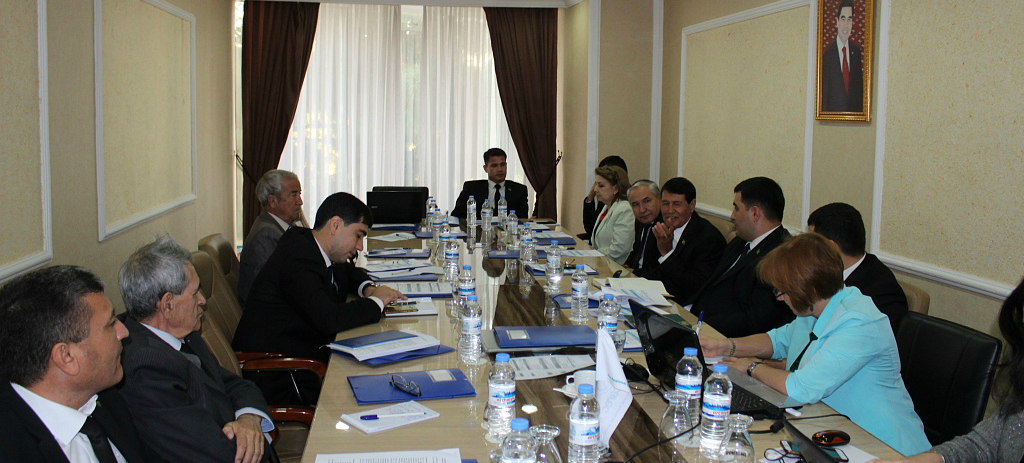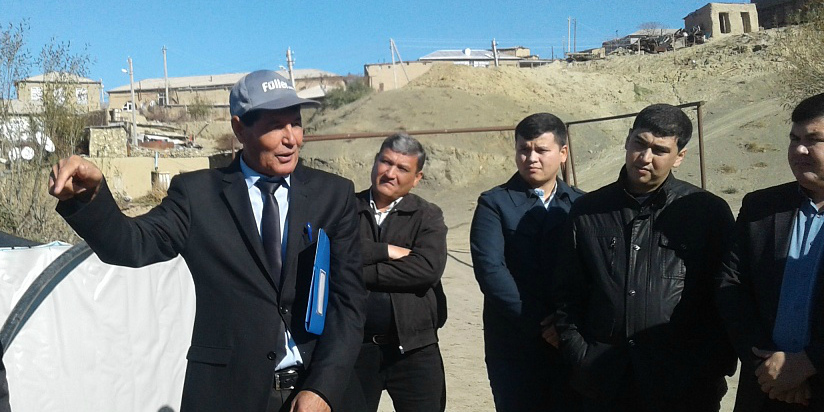Ashgabat hosted a round table on best practices in the use of water, land and energy resources
Within the framework of Turkmenistan's chairmanship, the EC IFAS in Ashgabat hosted a round table on best practices in the use of water, land and energy resources, as well as environmental protection in Central Asia. The round table was organized by the CAREC project office in Turkmenistan in cooperation with the SIC ICSD with the support of the Ministry of Agriculture and Water Management of Turkmenistan.

Together with CAREC and the “Torangy” economic company, an excursion was organized to the village “Kone-Gummez”, “Bakharly etrap” in Ahal region to demonstrate one of the practices in the field of water-saving technologies and effective use of water resources.
The events took place on November 15-16 2017, on the eve of the final conference of the “Promotion dialogue for conflict prevention related to water nexus in Central Asia. Central Asia Water Nexus Cooperation (CAWECOOP) project, which was held on November 21 in Almaty, Kazakhstan.
During the discussion, the main results of the CAWECOOP project were presented to the participants: 1) launch of the Central Asian International Environmental Forum, which was held in Ashgabat on June 5-7, 2017; 2) creation of a regional platform for representatives of the MFA and Parliaments of the Central Asian countries; 3) prepared participation of the group from Central Asian countries at the World Water Week in 2016 and 2017 and other project results.
However, an especially detailed attention was drawn to the interactive map, the name of which is consonant with the name of the round table: Map of the best practices of water, land and energy resources use, and environmental protection in Central Asia. On the issues of its content and the possibility of using, finalizing and supplementing.
The review of the best practices in the region and the presentation of the database and interactive map was made from CAREC by Ludmilla Kiktenko, Environmental Management Programme Manager. She described in detail the structure of the interactive map and the description of practices from the five Central Asian countries. Examples of the best practices were selected according to specific performance criteria.
The presentation aroused lively interest and discussion. Participants noted that the map is a unique opportunity to learn about the best practices in the region, to exchange opinions and implement them in accordance with local conditions. This is a good opportunity to maintain cooperation with water users of neighboring countries, as the map contains contact details of their developers and users. Moderator Dovlet Djumakuliyev, Turkmen CO Coordinator of CAREC projects in Turkmenistan, noted that the dissemination of information on best practices is important because it affects the formation of an ecological culture of water consumption. In conditions of decreasing water resources in the region, it is important to disseminate information on best practices of rational water consumption and this map can play a role among water users in the region.
The map is an open resource for all stakeholders, both for access to information and for disseminating information about their best practices. The link to the map is temporarily located at http://project1.xo.uz/base. In the near future, it will be moved to the CAREC website.

Participants of the round table: deputy directors, heads of departments as well as key specialists of the following organizations: the Ministry of Agriculture and Water Management of Turkmenistan, the Mejlis of Turkmenistan, the Ministry of Finance and Economy of Turkmenistan, the National Committee for Hydrometeorology under the Cabinet of Ministers of Turkmenistan, the Academy of Sciences of Turkmenistan, Institute of “Turkmensuvylymtashlama”, EC IFAS, Turkmen Agricultural University named after S.A. Niyazov, SIC ICSD, Secretariat of ICSD, National Institute of Desert, Flora and Fauna of the State Committee for Environmental Protection and Ecology.
On November 16, 2017 the group visited “Kone-Gummez” village in the Baharly Etrap of the Akhal Velayat region, where water supply system based on water saving technologies was introduced. At the place of water exit from well, detachable 50м³ water reservoir was installed in order to strength accumulation system, water use and water supply at this place. Water from the reservoir goes directly to the irrigation ditch which excludes unjustified loss of water and its spillage into settling ditch. This practice increases the flow of water from the well to consumers, increases the efficiency of its use, prevents land degradation and influences the improvement of the ecological situation in the village.
Replacement of pumps increases the effect of the assistance provided, as it improves the water debit in the village and allows to specialize wells. Two wells can be used for economical purposes, and one can be used for drinking and household purposes.
At the same time, the introduction of methods when water is used with water-saving instruments also has a social and cultural impact that will contribute to the development of ecological culture. As new water-saving tools are developed public awareness of value of water will increase which will shape skills of rationale water use at the household level.
Participants carefully examined presented installments, asked questions and gave their comments. In particular, they noted that water produced from wells is fresh and for its use in agricultural purposes it is needs to be enriched to a certain level of mineralization. This also should be taken into account while using water for agricultural purposes.
